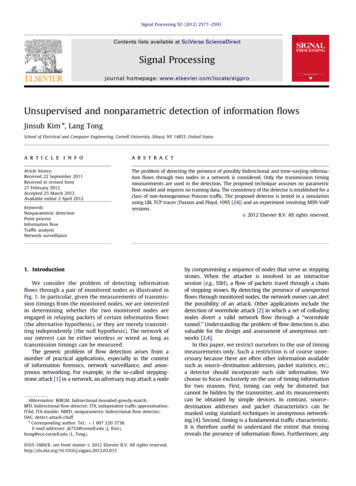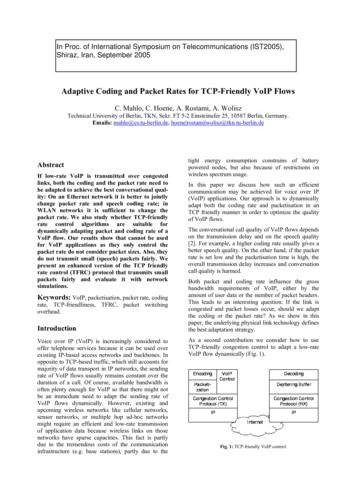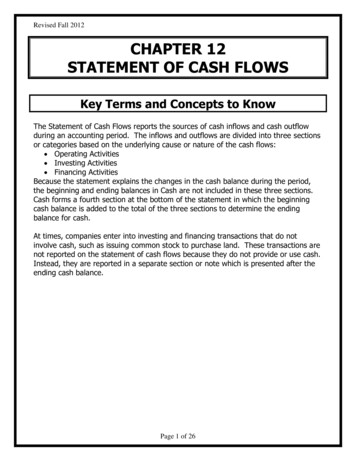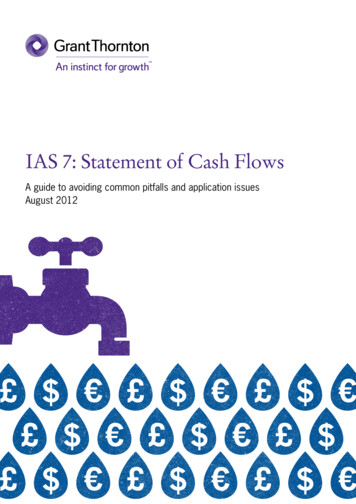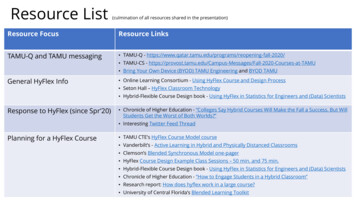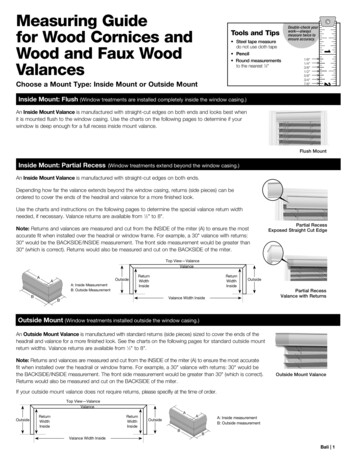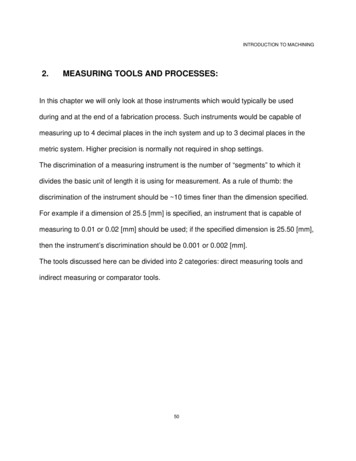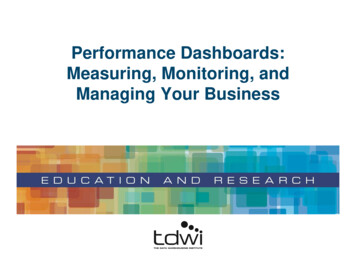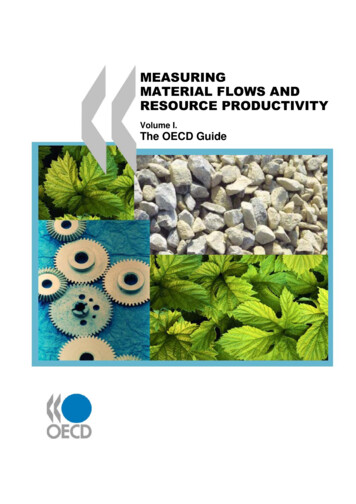
Transcription
MEASURINGMATERIAL FLOWS ANDRESOURCE PRODUCTIVITYVolume I.The OECD Guide
MEASURING MATERIAL FLOWS ANDRESOURCE PRODUCTIVITYVolume I.The OECD Guide
ORGANISATION FOR ECONOMIC CO-OPERATIONAND DEVELOPMENTThe OECD is a unique forum where the governments of 30 democracies work together to address the economic,social and environmental challenges of globalisation. The OECD is also at the forefront of efforts to understandand to help governments respond to new developments and concerns, such as corporate governance, theinformation economy and the challenges of an ageing population. The Organisation provides a setting wheregovernments can compare policy experiences, seek answers to common problems, identify good practice andwork to co-ordinate domestic and international policies.The OECD member countries are: Australia, Austria, Belgium, Canada, the Czech Republic, Denmark, Finland,France, Germany, Greece, Hungary, Iceland, Ireland, Italy, Japan, Korea, Luxembourg, Mexico, theNetherlands, New Zealand, Norway, Poland, Portugal, the Slovak Republic, Spain, Sweden, Switzerland,Turkey, the United Kingdom and the United States. The Commission of the European Communities takes part inthe work of the OECD.OECD Publishing disseminates widely the results of the Organisation’s statistics gathering and research oneconomic, social and environmental issues, as well as the conventions, guidelines and standards agreed by itsmembers.This work is published on the responsibility of the Secretary-General of the OECD. Theopinions expressed and arguments employed herein do not necessarily reflect the official viewsof the Organisation or of the governments of its member countries. OECD 2008No reproduction, copy, transmission or translation of this publication may be made without written permission. Applications should be sent to OECDPublishing: rights@oecd.org or by fax (33 1) 45 24 99 30. Permission to photocopy a portion of this work should be addressed to the Centre françaisd'exploitation du droit de copie, 20, rue des Grands-Augustins, 75006 Paris, France (contact@cfcopies.com) or (for US only) to Copyright ClearanceCenter (CCC), 222 Rosewood Drive, Danvers, MA 01923, USA, fax 1 978 646 8600, info@copyright.com.
Measuring material flows and resource productivityThe OECD GuideINTRODUCTIONThis report is part of the OECD programme on material flows and resource productivitythat supports the implementation of the OECD Council recommendation on MF and RP adopted inApril 2004. It is the first volume of a series of guidance documents on Measuring material flowsand resource productivity that have been drafted in a joint effort by a group of experts from OECDcountries led by the OECD Secretariat1. It benefited from contributions by members of the OECDWorking Group on Environmental Information and Outlooks and the Working Group on WastePrevention and Recycling, the Eurostat Task Force on Material Flows, and the London Group onEnvironmental Accounting. In developing this report, the co-operation of environmentaladministrations, statistical services and material flow experts in countries has been invaluable. Oursincere thanks are therefore extended to all concerned.The work has benefited from a sequence of workshops hosted by member countries (Helsinki,June 2004; Berlin, May 2005; Rome, May 2006; Tokyo, September 2007), that brought togetherenvironmental administrations, statistical services, material flow experts and researchers.The guidance documents provide guidance on methodological and measurement issuesrelated to material flow analysis (MFA), including the development of material flow accounts andrelated indicators. Emphasis is put on tools that can be used by country governments to support thedevelopment and implementation of national policies and related international work.The main objectives are to: Provide an accessible guide to the measurement of material flows (MF) and resourceproductivity (RP) for those involved in constructing and interpreting such measures, includingnational statistical offices, relevant government agencies, policy analysts and researchers;and facilitate the dissemination and uptake of existing experience and guidance. Identify desirable characteristics of MF and RP measures in accordance with policyquestions and uses, and by reference to a coherent framework that links the concepts ofsystem analysis and integrated environmental economic accounting. Improve international harmonisation and convergence: although the documents arenot prescriptive, they point out those areas in which harmonisation of methods isrecommended so that results are coherent and can be used in international work. Somediversity in their implementation is expected, for example in the coverage of naturalresources or materials that necessarily reflects the varying economic and environmentalimportance of a given resource or material flow for different countries.The guidance documents reflect the state of the art concerning experience with material flowanalysis and related indicators in member countries. It is expected that they will evolve as ongoingefforts on methodologies and measurement systems will show results and as more feedback willbecome available on the policy uses of MF information and indicators.1Experts and consultants: Mr. Derry Allen, Mr. Stefan Bringezu, Mr. Aldo Femia, Mr. Tomas Hak, Mr. Jan Kovanda, Mr. Yuichi Moriguchi, Mr. Heinz Schandl,Mr. Karl Schoer, Mr. Eric Turcotte, Ms Aya Yoshida. OECD Secretariat: Ms Myriam Linster. The financial and in-kind support of the Czech Republic, Finland,Germany, Italy, Japan, Luxembourg, and the United States is gratefully acknowledged. OECD 20083
The OECD GuideMeasuring material flows and resource productivityThe guidance documents include: Volume I. The OECD guide.Volume I describes the full range of MF approaches and measurement tools, with a focus onthe national level and emphasis on areas in which practicable indicators can be defined. It istargeted at a non expert audience. It includes (i) an overall framework for material flowanalysis (MFA), (ii) a description of different kinds of measurement tools, (iii) a discussion ofthose issues and policy areas to which MFA and material flow indicators can best contribute,and (iv) guidance on how to interpret material flow indicators. It is illustrated with a selectionof practical examples from countries' experience and is complemented with a glossary. Volume II. The accounting framework.Volume II provides a theoretical and technical description of the concepts and methodologiesof material flow accounting. It is targeted at an expert audience. It draws upon the Handbookon national accounting - Integrated Environmental and Economic Accounting (the SEEAhandbook), developed jointly by the United Nations, the European Commission, the IMF, theOECD, and the World Bank and on the guide published by Eurostat in 2001 Economy-widematerial flow accounts and derived indicators – A methodological guide. It has benefited fromco-operation with Eurostat and with the London Group on Environmental Accounting, andconsultations with the UNSD and its Committee of Experts on Integrated EnvironmentalEconomic Accounting. Volume III. Inventory of country activities.Volume III takes stock of activities related to the measurement and analysis of naturalresource and material flows in place or planned in OECD countries and in selected nonmember economies. It describes the main features that characterise such activities and theextent to which information on material resources is used in environmental reporting and indecision making. It is designed to provide a factual basis for the further exchange ofexperience and information, and for sharing lessons at international level. Volume IV. Implementing national MF Accounts (forthcoming, prepared jointly withEurostat).Volume IV provides practical guidance to assist countries in implementing national materialflow accounts. It is targeted at practitioners of material flow accounting. It is constructed in amodular way to reflect several levels of ambition and completeness of accounts, and is beingdeveloped stepwise. The first edition will focus on the establishment of simple economy-widematerial accounts building on a set of core tables tested and used by Eurostat.The guidance documents are complemented by a synthesis report that summarises the work carriedout, takes stock of progress made, and adds selected examples from applications of MFA.The guidance documents are published on the responsibility of the Secretary General of the OECD.4 OECD 2008
Measuring material flows and resource productivityThe OECD GuideMEASURING MATERIAL FLOWS AND RESOURCE PRODUCTIVITYThe OECD GuideEXECUTIVE SUMMARY9CHAPTER 1. NATURAL RESOURCES, MATERIALS AND THE ECONOMY 191.BACKGROUND AND POLICY CONTEXT202.SUSTAINABLE RESOURCE USE AND RESOURCE PRODUCTIVITY223.KNOWLEDGE GAPS AND INFORMATION NEEDS254.THE VALUE OF MATERIAL FLOW STUDIES26CHAPTER 2. ANALYSING MATERIAL FLOWS: A TOOL FOR DECISION MAKING 271.USEFULNESS FOR ECONOMIC, TRADE AND TECHNOLOGY DEVELOPMENT POLICIES291.1.1.2.1.3.293032Economic aspectsTrade aspects & supply patternsTechnology development aspects2.USEFULNESS FOR NATURAL RESOURCE MANAGEMENT POLICIES333.USEFULNESS FOR ENVIRONMENTAL POLICIES343.1.3.2.3.3.3.4.35363636Identify system-wide sources of pollution and opportunities for pollution preventionIdentify system-wide waste of materials and opportunities for efficiency gainsCharacterise products and identify opportunities for efficiency gains and pollution preventionOther environmentally relevant applicationsCHAPTER 3. OVERALL FRAMEWORK FOR MATERIAL FLOW ANALYSIS 391.2.3.CHARACTERISTICS AND CONCEPTUAL FOUNDATIONS401.1.1.2.1.3.404143ARCHITECTURE AND LEVELS OF APPLICATION442.1.2.2.44476.50Monitoring material flows at economy-wide level: Economy-wide material flow accounts and balances 50Implementing macro-level MFAcc51MESO-LEVEL MFA4.1.4.2.4.3.5.Material flow related analyses and associated issues of concernLinks between MF information, other measurement tools and analytical approachesMACRO-LEVEL MFA3.1.3.2.4.CharacteristicsConceptual foundationsTerminology and language conventions51Monitoring material flows at industry level: Physical input-output tables, and NAMEA-type approaches 52Monitoring particular materials: Individual material flow accounts and material system analysis53Implementing meso-level MFAcc53MICRO-LEVEL MFA545.1.5.2.5.3.Monitoring material flows at business or local levelMonitoring selected substances: Substance flow accounts and analysesMonitoring the material requirements of products: Life cycle inventories and assessments545757OVERVIEW OF INFORMATION VALUES AND POLICY APPLICATIONS OF MFA TOOLS58 OECD 20085
The OECD GuideMeasuring material flows and resource WANDRESOURCEPRODUCTIVITY INDICATORS 631.2.3.ROLE AND G MATERIAL FLOW 794.1.4.2.4.3.4.4.4.5.7980818383Level of aggregation and aggregation methodsRelation to environmental pressures and impactsAnalytical soundnessData accessibility and accuracyGuidance for usePURPOSES AND USES OF MATERIAL FLOW INDICATORSMonitorMonitorMonitorMonitorMonitorthe material basis of national economies and industriesthe material productivity of national economies and industriesthe implications of trade and globalisation for material flowsthe management of selected resources and materialsthe environmental impacts of material resource useUSING MATERIAL FLOW INDICATORS6.1.6.2.6.3.6.4.7.Input indicatorsConsumption indicatorsBalance indicatorsOutput indicatorsEfficiency indicatorsOther indicatorsAGGREGATED MF INDICATORS: STRENGHTS AND LIMITS5.1.5.2.5.3.5.4.5.5.6.Defining the purpose and the level of ambition of the indicator effortStructuring elementsDesirable propertiesSelection and validation criteriaMAIN TYPES OF MF INDICATORS AND THEIR RELATION TO THE MATERIALS BALANCE 763.1.3.2.3.3.3.4.3.5.3.6.4.TerminologyLevels of applicationFunctions, audiences and purposesData sources and calculation methodsGuiding principlesFactors having a bearing on the relevance of MF indicatorsEnhancing the information value of MF indicatorsCommunicating indicator results to a non-expert audience86868895100104115115116119121PRACTICAL MATERIAL FLOW INDICATORS FOR NATIONAL AND INTERNATIONAL USE 122CHAPTER 5. ESTABLISHING THE INFORMATION BASE 1251.MATERIAL FLOW ACCOUNTS1.1.1.2.2.RECOMMENDATIONS FOR A FIRST IMPLEMENTATION2.1.2.2.2.3.2.4.3.Main characteristicsMain functions and analytical applicationsDefining the purpose and the level of ambition of the effortInstitutional arrangements and partnershipsIdentifying available statistical sourcesInterpretation and dissemination of resultsIMPLEMENTATION MODULES126126129130130131132133133ANNEX. GLOSSARY OF TERMS RELATED TO MATERIAL FLOW ANALYSIS AND RESOURCEPRODUCTIVITY137REFERENCES6159 OECD 2008
Measuring material flows and resource productivityThe OECD GuideList of eTableTableTableTable1. Schematic representation of an economy-wide material balance scheme . 422. Schematic representation of material flows through the commercial life-cycle . 423 Architecture and level of application of MFA tools . 464. Information pyramid . 655. Main groups of MF indicators and their relation to the materials balance . 786. Material cycle indicators derived from MFA . 1037. Schematic representation of material flows, en
natural resources, materials and the economy _ 19 1. background and policy context 20 2. sustainable resource use and resource productivity 22 3. knowledge gaps and information needs 25 4. the value of material flow studies 26 chapter 2. analysing material flows: a tool for decision making _ 27 1. usefulness for economic, trade and .

